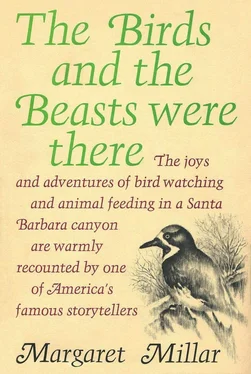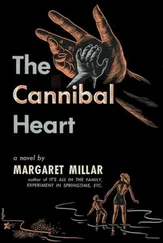Маргарет Миллар - The Birds and the Beasts Were There
Здесь есть возможность читать онлайн «Маргарет Миллар - The Birds and the Beasts Were There» весь текст электронной книги совершенно бесплатно (целиком полную версию без сокращений). В некоторых случаях можно слушать аудио, скачать через торрент в формате fb2 и присутствует краткое содержание. Город: New York, Год выпуска: 1967, Издательство: Random House, Жанр: Природа и животные, на английском языке. Описание произведения, (предисловие) а так же отзывы посетителей доступны на портале библиотеки ЛибКат.
- Название:The Birds and the Beasts Were There
- Автор:
- Издательство:Random House
- Жанр:
- Год:1967
- Город:New York
- ISBN:нет данных
- Рейтинг книги:4 / 5. Голосов: 1
-
Избранное:Добавить в избранное
- Отзывы:
-
Ваша оценка:
- 80
- 1
- 2
- 3
- 4
- 5
The Birds and the Beasts Were There: краткое содержание, описание и аннотация
Предлагаем к чтению аннотацию, описание, краткое содержание или предисловие (зависит от того, что написал сам автор книги «The Birds and the Beasts Were There»). Если вы не нашли необходимую информацию о книге — напишите в комментариях, мы постараемся отыскать её.
The Birds and the Beasts Were There — читать онлайн бесплатно полную книгу (весь текст) целиком
Ниже представлен текст книги, разбитый по страницам. Система сохранения места последней прочитанной страницы, позволяет с удобством читать онлайн бесплатно книгу «The Birds and the Beasts Were There», без необходимости каждый раз заново искать на чём Вы остановились. Поставьте закладку, и сможете в любой момент перейти на страницу, на которой закончили чтение.
Интервал:
Закладка:
The differences between the two jays are many: size, color, voice, behavior, body-wing-tail ratio, dimensions of nests and of eggs, even the shape of the beak, which, in the island bird, is the same length but bulkier, almost half an inch deep at the nostril. This jay is heavier, has a longer tail and a sturdier body, but to me the most striking difference is in color. His plumage is a deeper and more vivid blue. Though some of his calls and actions resemble those of our mainland jay, his disposition is gentler, perhaps softened, as Dawson suggests, by the year-round food supply for which there is little competition, the equable climate, warmed in winter and cooled in summer by the sea, and by the lack of human interference with his affairs.
Because his wings are too weak to support his body in any sustained effort of flight, the Santa Cruz Island jay is fated to remain forever on his lonely island. There we see him every May and September when the Santa Barbara Audubon Society crosses the channel to check the migrations of pelagic birds like shearwaters, petrels and alcids. In order to land on the island, permission from the owners is required. This is often tedious, and for our purposes unnecessary, since the straight cliffs of the shoreline permit boats to cruise or anchor very close in. The flirt of a bright tail among the live oaks, a patch of cobalt blue gliding up through the Monterey pines as if it were attached to a sky hook — these mark the Santa Cruz Island jay, a bird unique.
Melanie was released from the galley fifty yards offshore. Rising on her toes like a ballerina, she lifted her great black wings and flew straight toward the land of her birth and of her destiny. She didn’t look back.
Since that day I have visited Santa Cruz Island many times and have seen in the sky bald eagles, peregrine falcons, red-tailed hawks, and of course, ravens, many ravens. But none of them wore a pink plastic band on its right leg. The band is probably gone anyway: she would have long since chewed it off as the last vestige of her flighty youth.
5
Morgan
Addiction to bird-watching may happen very suddenly as it did to me, or it may be a slower and quieter thing, as in my husband’s case.
From the beginning he adjusted well to the necessary changes in our household. He ate our much simpler meals without complaint, he was careful to avoid getting too close to the picture windows, he looked and listened with patience while I pointed out the ordinary birds that were now coming daily to the ledge and the feeders, and the grapes and doughnuts in the trees: house finches, song sparrows, scrub jays, mourning doves, wrentits, mockingbirds and towhees. The brown towhee, Houdunit, was practically a member of the family by this time, but of the rufous-sided towhee we could catch only glimpses as he foraged, both feet at a time, in the underbrush or flew low across the canyon. We had to wait until the following spring to see him right out in the open, singing his wheezy waltz: too-wheee — 1, 2, 3 — too - wheeee — 1, 2, 3 — too-wheee — 1, 2, 3 .
On very rare and special occasions the rufous-sided towhee has come up into the tea tree for a furtive bite of doughnut, but to this day he has never appeared on the ledge or any of the feeders. Often, especially just before twilight, we hear his plaintive question: Aaay? Aaay? From bush to bush he goes, asking over and over again, Aaay? What is life? Aaay? How did it start? Aaay? Where will it all end? But nobody ever answers.
Perhaps the nearest thing to an answer appears in the month of May. We catch sight of it as it hurries through the underbrush of the canyon, looking like a large black sparrow. Only the choice of flyway and the white outer tail feathers identify it as a young rufous-sided towhee.
The critical point in my husband’s conversion came one morning in early August. I was in my office working on a book. When I emerged for a tea break I found Ken at the dining-room table with the two field guides open in front of him and my binoculars hanging from his neck. “Have you ever seen a band-tailed pigeon?” he said casually. “There’s one on the feeder in the eucalyptus tree.”
The first band-tailed pigeon is an event, an experience. This is partly because of his size — he’s larger than the domestic pigeon — and partly because he is wild, a bird of the woodlands, not of the city streets or the ledges of office buildings. He also differs from the domestic pigeon in having, at maturity, a white crescent around the nape of his neck and a light grey, sometimes almost white, band at the end of his tail, which is very broad and can be spread out into a fan — hence the common misnomer, fan-tailed pigeon. Unlike all other North American pigeons, and doves, he has a yellow bill with a purplish-black tip, and feet that seem to have been painted to match, yellow with purplish-black toenails. He looks as though the moment of his creation had been a summer morning and the place a wild elderberry bush and one ripe dewy berry had clung to his beak and one to each toenail.
While these birds most frequently nest in oaks, and acorns are a main part of their diet, it is with eucalyptus trees that I associate them. We see them perched in these trees more often than any others. When the blue gum eucalyptus is very young, or when an older tree is putting out new leaves, the leaves are so different in color and shape from the older ones that they appear to belong to a separate family. These leaves are a soft velvety blue-grey, exactly like the plumage of the bandtails perched among them. No doubt this is just a happy accident, though it sometimes seems that the eucalyptus, like a good host trying to please his guest, grows new leaves to match the bandtails.
What is the difference between a pigeon and a dove?
People frequently ask this question and seem disappointed in the answer: there is no difference. The terms are interchangeable, and the birds eating milo and cracked corn on our ledge could just as well be called band-tailed doves and mourning pigeons. Although in general practice smaller birds are known as doves and larger ones as pigeons, this isn’t a rule. The Supreme Court of bird watchers, the American Ornithological Union, lists the domestic pigeon under the name rock dove.
However the columbine grapevine works — perhaps in a kind of pidgin English — it is quick and efficient in spreading the word about a new feeding and watering area. By week’s end our bandtail’s immediate family was well established and every hour brought a new batch of obscure in-laws and fifty-second cousins and friends of friends of friends. They all took an immediate fancy to the birdbath with the continuous drip. They stood on it, they drank from it, immersing their beaks to the nostrils and drawing in the water; they showered, lifting first one wing, then the other, letting the drip trickle down onto their wing pits.
Band-tailed pigeons share with some other flocking birds a custom that serves the species well in the wild but is not expedient at a feeding station. A bandtail arriving at dawn for breakfast doesn’t immediately go to the feeder and start eating. Instead, he perches in one of the eucalyptus trees, and even though he must be hungry he waits quietly for his friends, now and then thrusting his head forward and back to appraise his surroundings more accurately. When a certain number of birds have arrived, as when a critical mass is reached in nuclear physics, the action starts. Suddenly, like clumsy blue butterflies, the pigeons begin falling out of the trees onto the feeder and the lower terrace. At one of these eucalyptical gatherings of the clan I have counted ninety-eight bandtails.
There must be some kind of signal to start this mass movement. If it’s a voice signal, I’ve never heard it; if it’s kinetic, either I haven’t seen it or don’t recognize it. It seems likely that one of the bandtails is the accepted leader and sets an example for the rest to follow. When he decides to eat, everybody eats — providing the dining area is a two-acre field, not a seed hopper with a perch meant for half a dozen birds.
Читать дальшеИнтервал:
Закладка:
Похожие книги на «The Birds and the Beasts Were There»
Представляем Вашему вниманию похожие книги на «The Birds and the Beasts Were There» списком для выбора. Мы отобрали схожую по названию и смыслу литературу в надежде предоставить читателям больше вариантов отыскать новые, интересные, ещё непрочитанные произведения.
Обсуждение, отзывы о книге «The Birds and the Beasts Were There» и просто собственные мнения читателей. Оставьте ваши комментарии, напишите, что Вы думаете о произведении, его смысле или главных героях. Укажите что конкретно понравилось, а что нет, и почему Вы так считаете.



![Маргарет Миллар - Rose's Last Summer [= The Lively Corpse]](/books/384369/margaret-millar-rose-s-last-summer-the-lively-c-thumb.webp)


![Маргарет Миллар - The Iron Gates [= Taste of Fears]](/books/433837/margaret-millar-the-iron-gates-taste-of-fears-thumb.webp)





